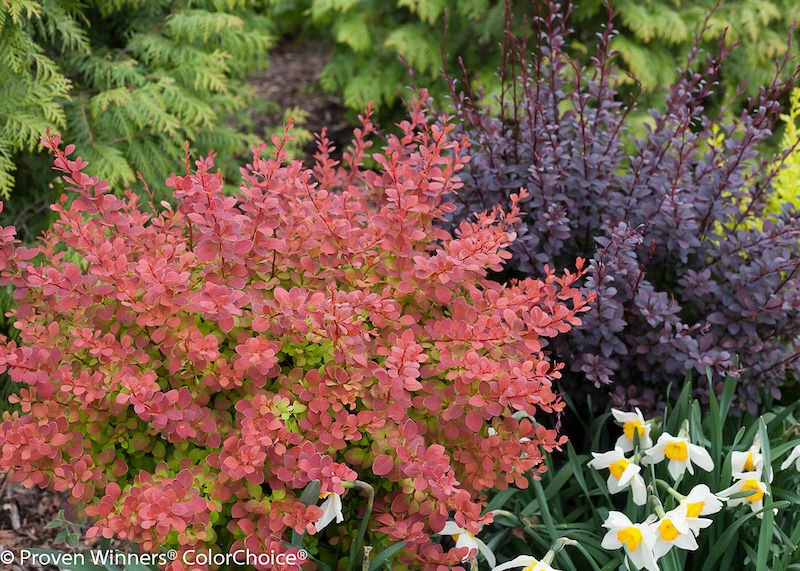Barberry is a large group of shrubs in the genus Berberis. Hardy to zones 4-9, these commonly planted shrubs can be evergreen or deciduous. Prized by gardeners, barberry is available in numerous cultivars and species. Its colorful foliage in shades of green, purple, yellow, red, and bronze is intensified in fall for a remarkable foliage display. It also produces ornamental red berries that persist into winter, providing year-long interest. Since barberry is low maintenance and deer resistant, it is commonly used in foundation plantings. The dense growth of barberry also takes well to pruning to create a thorny hedge. Because it is so versatile, barberry can be used in formal gardens, containers, shade gardens, and mixed borders.
Once established, barberry is drought resistant. This shrub can adapt to a wide variety of soil conditions, although it prefers well-drained soil with an acidic to neutral pH. Barberry grows best in full sun to partial shade. It can grow 2-6 feet tall and 3-8 feet wide. Check with your local extension office before planting barberry, as some species are invasive in certain states.

Shrubs To Plant With Barberry
Create a mixed hedge by planting barberry alongside boxwood. Together, these shrubs can form a living fence to section off your garden or keep unwanted wildlife out. Construct layers in your landscape by planting barberry with evergreen shrubs such as arborvitae and creeping juniper. The tall, vertical growth of arborvitae makes an excellent backdrop for barberry, while the sprawling, low-growing form of creeping juniper acts as a thick ground cover in front of barberry. These plants will add structure to your garden while staying green year-round.
Flowering shrubs partner well with barberry. The fragrant purple flowers of lilac harmonize with the deep foliage color of numerous barberry cultivars. Summersweet and hydrangeas produce clusters of eye-catching flowers that help create a colorful garden when paired with barberry. For an unexpected color combination, grow barberry with coralberry. The unique clusters of coralberry’s pink drupes accompany barberry’s red fruit throughout winter.

Perennials To Plant With Barberry
Barberry makes an excellent backdrop for perennials. Grow daffodils with barberry for a classic, cheerful combination in spring. Plant hardy geraniums and astilbe around barberry in partial shade. Dark-colored barberry will illuminate the abundant blooms of geranium and feathery plumes of astilbe. In shady spots, grow it with coral bells and lady’s mantle. These perennials both have contrasting foliage with delicate spikes of flowers in late spring to early fall. They also act as ground covers, brightening empty spots in the shade while suppressing weeds.
In sunny locations, interplant red-leaved barberry with tall ornamental grasses like bluestem, muhlenbergia, and pennisetum. The fine, wispy grass foliage adds textural interest and complements the branched structure of barberry. For a natural, colorful effect, incorporate mounding and flowering plants like false indigo, catmint, coreopsis, and amsonia to attract pollinators and provide pops of color.
Annuals To Plant With Barberry
As with perennials, barberry’s consistent form makes a wonderful backdrop for annual plants, allowing you to try out a variety of designs. When growing barberry with annuals, play around with colorful foliage and flower combinations to highlight barberry’s attractive foliage. Barberry with purple or lime green leaves is striking when paired with a celosia with deep pink or burgundy flowers. Dusty miller’s silvery-white foliage contrasts nicely with barberry’s rich foliage colors. Pineapple sage’s bright red blossoms are enriched by colorful barberry leaves. Finish the look by using alyssum as an abundantly flowering ground cover.
Best Companion Plants For Barberry in Containers
Barberry is one of the best shrubs for container planting. With its easy-to-maintain size and form, barberry can work as a neutral focal point in many container designs. Add coral bells to fill in the surrounding space and provide an additional source of vibrant foliage. Plant trailing petunias and lamium around barberry for a pretty flowering spiller combo. Water the container a few times per week to prevent it from drying out.

Plants Not To Grow With Barberry
While barberry can grow well with many plants, it can have negative ecological impacts. Both Japanese and European barberry (Berberis thunbergii and Berberis vulgaris) are listed as invasive species in several US states. Barberry spreads both vegetatively and by seed. These plants can invade natural areas, particularly forests, and crowd out native plants. In particular, barberry is known to shade out spring ephemerals due to its early leaf emergence. It can also alter the soil pH, making it more basic and thus potentially harmful to surrounding plants.
If barberry is invasive in your area, consider planting a native or non-invasive species such as American barberry (Berberis canadensis). Several sterile cultivars of Japanese barberry also exist. Do not plant barberry with small, slow-growing, or early spring emerging plants that may be easily outcompeted or shaded out by this shrub.
Best Plants To Grow With Barberry
Barberry can be planted with many shrubs, perennials, and annuals in well-drained soil and full sun to partial shade. Grow it with evergreens like boxwood, arborvitae, and juniper for year-round color and privacy. Adding grasses and flowering plants like lilacs, hydrangeas, summersweet, coralberry, astilbe, hardy geraniums, false indigo, and amsonia can help to create a natural, wildlife-friendly garden. Create a colorful garden by planting barberry with celosia, dusty miller, and pineapple sage. Plant barberry in containers with fillers such as coral bells and flowering spillers like petunias and lamium.
 |
Lauren Youngcourt - Published 12-12-2023 |
